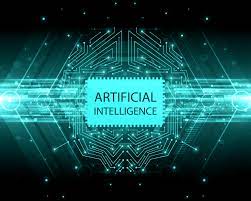Disclosure: This post is entirely human-written, with the help of word-processing software, online search engines, and digital exchanges with fellow humans.

Once upon a time, artificial intelligence (AI) was the stuff of apocalyptic science fiction, usually featuring anthropomorphic robots in revolt against humanity. Then humanity got used to real-life robots that do everything from vacuuming floors to exploring outer space, and the popular image of AI changed from a potential enemy to an everyday helper.
But AI technology continues to evolve, and fears about how far it will go are again becoming everyday concerns. Unfortunately, worst-case scenarios (usually exaggerated and often completely without foundation) blind many to the positive side. When we’re willing to properly use and understand AI, it has tremendous potential to change our world for the better, not least by enhancing assistive technology.
BridgingApps is all about helping people get the most from assistive technology. Here are a couple of personal-experience perspectives on the benefits of one popular AI system, ChatGPT.

Marjorie Reichard, BridgingApps Project Manager:
I have used ChatGPT for brochure content, grant writing, and email to recruit Digital Navigators. It’s very easy: I was using it within minutes of creating an account. I tend to leave out things when I write, but with ChatGPT, I just have to type a couple of phrases and it will generate paragraphs for me. And if I am stuck—or when there are lots of ideas in my head that I can’t seem to get out in a logical format—I can write a few concepts and the AI generates the content.
One drawback is that it tends to be too verbose, putting in way more details than I want to convey. So the content still must have thorough human editing after generation. You have to really read it and make sure the content is correct; but for me, the final result still is ready faster than if I were trying to generate the whole thing personally.
One additional plus: it doesn’t hurt ChatGPT’s feelings if I don’t like what it generates. I just change the starter phrasing, and different content is generated within seconds—no arguments, no delays. I wouldn’t say it could replace human writers—it can’t consider the audience and adjust writing style to fit—but it’s an amazing tool and definitely helps me do better.
Jacob Fuchs, teen entrepreneur, son of BridgingApps Program Manager Amy Fuchs:
In my business, I use ChatGPT almost every day for ads, websites, and other content—also business plans, marketing strategies, operations processes, market research, lead generation, graphic design, and most everything else except articles. ChatGPT does everything significantly faster than I could, and often is more creative. Plus, the software is extremely easy to learn—anyone who can work a smartphone can figure it out.
I don’t usually have to fact check, either: the AI is already saying what I told it to say. I think it makes less mistakes than most humans.
Not just anyone can get top-quality content out of AI, though: it takes someone who understands how to plug in the right keywords, and that took me a while to truly figure out. Once the content is produced, I read it and see if I like it: then I copy and paste it where it needs to go; fill in things like phone numbers and website domains; and change some wording or add a personal touch if needed. (ChatGPT doesn’t truly know your business or your customers, so it may lack some personal touches.)
After my business gets bigger, I’ll hire a copywriter who’s highly skilled in both AI and human-generated writing, to produce the best content possible. (Side note: In my opinion the best way to write an article with AI is to create one paragraph at a time, starting with the intro: the AI soon figures out that this will all be one article, and can produce paragraphs that go with the one before—if you plug in your commands and words right.)
Closing Notes
At its core, the AI revolution is no different from any other paradigm shift that has impacted human society. Since fire and the wheel, society’s response to major new technologies has followed a predictable pattern:
- Fear
- Experimentation
- Acceptance and Adoption
- Integration
- Ongoing Adjustments
With machine-learning, idea-generating AI, our society today is still in the earliest stages of this process. The healthy, proactive approach is to:
- Keep learning and exploring the potential;
- Expect ongoing trial and error;
- Make a habit of trying things before judging them;
- Always look for—and embrace—the positive aspects.
For Further Reading
- AI in the classroom: What’s cheating? What’s OK?
- Breaking the Chains of IDD Otherism: How AI and Blockchain Will Empower Individuality
- Debunking AI Myths: The Truth Behind 5 Common Misconceptions
- Despite How the Media Portrays It, AI Is Not Really Intelligent. Here’s Why.
- Plagiarism Checkers: The Benefits Students Fail to See
- 3 Steps to Prepare Your Culture for AI

